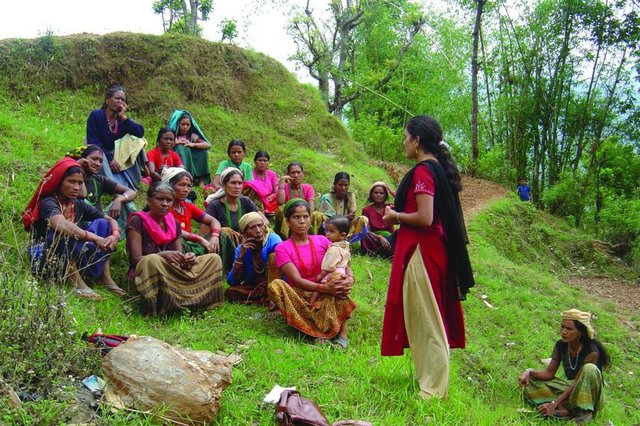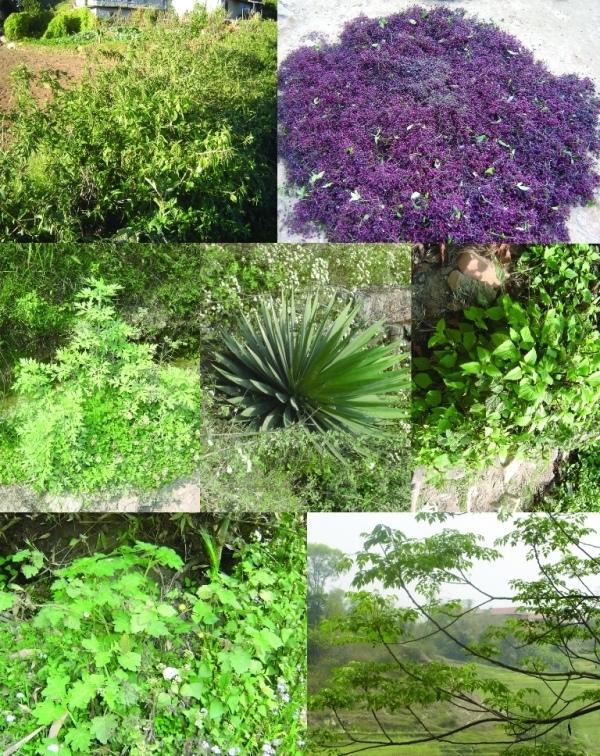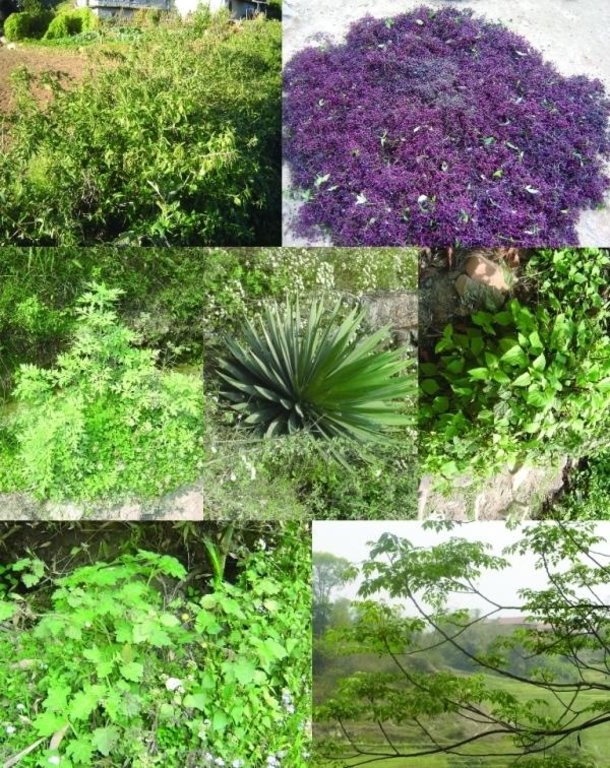Organic pest management [Nepal]
- Criação:
- Atualização:
- Compilador/a: Richard Allen
- Editor: –
- Revisor: David Streiff
Jaibik rogkira byabasthapan (Nepali)
technologies_1755 - Nepal
Veja as seções
Expandir tudo Recolher tudo1. Informação geral
1.2 Detalhes do contato das pessoas capacitadas e instituições envolvidas na avaliação e documentação da tecnologia
Especialista em GST:
Director
+977 1 5520314
Soil Management Directorate, Department of Agriculture
Nepal
Especialista em GST:
Team Leader
+977 1 5543591
ssmp@helvetas.org.np
Sustainable Soil Management Programme
Nepal
Nome do projeto que facilitou a documentação/avaliação da Tecnologia (se relevante)
Sustainable Soil Management Programme, Nepal (SSMP)Nome da(s) instituição(ões) que facilitou(ram) a documentação/ avaliação da Tecnologia (se relevante)
Department of Agriculture, Soil Management Directorate, Hariharbhawan Lalitpur (doasoil) - NepalNome da(s) instituição(ões) que facilitou(ram) a documentação/ avaliação da Tecnologia (se relevante)
HELVETAS (Swiss Intercooperation)1.3 Condições em relação ao uso da informação documentada através de WOCAT
Quando os dados foram compilados (no campo)?
06/11/2008
O/a compilador/a e a(s) pessoa(s) capacitada(s) aceitam as condições relativas ao uso de dados documentados através da WOCAT:
Sim
1.5 Referência ao(s) questionário(s) sobre as abordagens da GST

Farmer field schools on integrated plant nutrient systems [Nepal]
Participatory and collaborative learning through the farmer field school approach
- Compilador/a: Richard Allen

Farmer-led experimentation [Nepal]
Participatory technology testing and adaptation through farmer-led experiments
- Compilador/a: Richard Allen

Farmer-to-farmer diffusion [Nepal]
Wider diffusion of sustainable soil management technologies through a demand responsive farmer-to-farmer diffusion approach
- Compilador/a: Richard Allen
2. Descrição da tecnologia de GST
2.1 Descrição curta da tecnologia
Definição da tecnologia:
Promotion of botanical pesticides for organic pest management and liquid manure
2.2 Descrição detalhada da tecnologia
Descrição:
Production of fresh vegetable is often hampered by pests which may reduce production and badly affect farmers’ income. Chemical pesticides are available and are used, sometimes excessively, to combat these pests in parts of Nepal’s midhills. Botanical pesticides prepared from a variety of plant ingredients soaked and fermented in cattle urine provide a suitable alternative to chemical pesticides, at least for subsistence and semi-commercial vegetable producers. These pesticides are based on farmer’s traditional knowledge and are emerging as alternatives to the
application of chemical pesticides.
All the ingredients for these pesticides are available locally; in some cases the plants are considered as weeds. Crofton weed (banmara) grows in abundance along roads and paths, and on forest floors and suppresses the growth of other more valuable species. It is believed to have pesticidal effects and is often used in botanical pesticides. The Nepali names of other plants commonly used in the tonics are asuro (malabara tree), titepati (mugwort), bakaino (Persian lilac), timur (Nepali pepper), patina (field mint), tulsi (sweet basil), neem, sisnu (stinging nettle), ketuke
(century plant), and khirro (tallow tree). In general it is said that herbs and plants that are bitter, pungent, or ‘hot’ or that produce a strong odour are most effective in botanical pesticides.
The botanical pesticide is diluted with water before applying to vegetable crops. The dilution ratio depends on the age and type of the plant being treated with a higher dilution for seedlings in nurseries than for mature plants. While botanical pesticides do not kill all pests, they do combat soft-bodied insects such as aphids and act as a repellent against larger insects like cutworms, various larvae, and red ants. They are not usually effective against plant diseases.
In some places innovative farmers have started to produce and sell botanical pesticides for pest management and as a liquid manure for foliar application.
2.3 Fotos da tecnologia
2.5 País/região/locais onde a tecnologia foi aplicada e que estão cobertos nesta avaliação
País:
Nepal
Especificação adicional de localização:
Midhills districts of Nepal
Map
×3. Classificação da tecnologia de GST
3.1 Principal/principais finalidade(s) da tecnologia
- Cheaper pest management
3.2 Tipo(s) atualizado(s) de uso da terra onde a tecnologia foi aplicada

Terra de cultivo
- Cultura anual
Comentários:
Major land use problems (compiler’s opinion): Intensifying cultivation practices and the increasing demand for fresh and off-season vegetables have increased the
incidence of pests. These pests are controlled mainly by chemical pesticides where available, and where they are not
available entire crops can be destroyed and farmers’ livelihoods endangered.
3.4 Grupo de GST ao qual pertence a tecnologia
- Gestão integrada de pragas e doenças (inclusive agricultura orgânica)
3.5 Difusão da tecnologia
Especifique a difusão da tecnologia:
- Uniformemente difundida numa área
3.6 Medidas de GST contendo a tecnologia

Medidas de gestão
- M7: Outros
3.7 Principais tipos de degradação da terra abordados pela tecnologia

Deteriorização química do solo
- Cn: declínio de fertilidade e teor reduzido de matéria orgânica (não causado pela erosão)
3.8 Redução, prevenção ou recuperação da degradação do solo
Especifique o objetivo da tecnologia em relação a degradação da terra:
- Reduzir a degradação do solo
4. Especificações técnicas, implementação de atividades, entradas e custos
4.2 Especificações técnicas/ explicações do desenho técnico
Technical knowledge required for field staff / advisors: low
Technical knowledge required for land users: low
Main technical functions: reduction in application of chemical pesticides, reduction in application of chemicalfertilisers
Secondary technical functions: supplementary irrigation
4.3 Informação geral em relação ao cálculo de entradas e custos
Especifique como custos e entradas foram calculados:
- por área de tecnologia
Especifique a moeda utilizada para os cálculos de custo:
- Dólares norte-americanos
Indique a média salarial da mão-de-obra contratada por dia:
2.00
4.4 Atividades de implantação
| Atividade | Tipo de medida | Periodicidade | |
|---|---|---|---|
| 1. | Different plants with pesticidal properties are collected and chopped into small pieces. Only tenderparts should be used to facilitate decomposition. | Gestão | |
| 2. | Other materials like ginger powder, green chilli, ash, and mustard cake are mixed with the chopped plant material | Gestão | |
| 3. | The material is placed in a plastic drum or earthen pot and soaked in cattle urine at the rate of about one kilogramme of solid material per 2 litres of cattle urine. | Gestão | |
| 4. | The drum is close as air-tight as possible and put in a shady place. | Gestão |
4.5 Custos e entradas necessárias para a implantação
| Especifique a entrada | Unidade | Quantidade | Custos por unidade | Custos totais por entrada | % dos custos arcados pelos usuários da terra | |
|---|---|---|---|---|---|---|
| Mão-de-obra | Labour | Persons/day | 2,0 | 2,0 | 4,0 | 100,0 |
| Equipamento | Drum | pieces | 1,0 | 6,0 | 6,0 | 100,0 |
| Custos totais para a implantação da tecnologia | 10,0 | |||||
4.6 Atividades recorrentes/manutenção
| Atividade | Tipo de medida | Periodicidade/frequência | |
|---|---|---|---|
| 1. | The botanical pesticide needs to be stirred with a wooden stick about every 15 days. | Gestão | |
| 2. | The prepared pesticide is normally ready for field application after about 35-40 days of fermentation/preservation. | Gestão | |
| 3. | The pesticide is diluted with water 1:4 (1 part pesticide solution: 4 parts water) for mature plants and 1:8 for nurseries and applied with a jug, sprayer, or broom. | Gestão |
4.7 Custos e entradas necessárias pata a manutenção/atividades recorrentes (por ano)
Comentários:
Cost as in January 2007
5. Ambiente natural e humano
5.1 Clima
Precipitação pluviométrica anual
- <250 mm
- 251-500 mm
- 501-750 mm
- 751-1.000 mm
- 1.001-1.500 mm
- 1.501-2.000 mm
- 2.001-3.000 mm
- 3.001-4.000 mm
- > 4.000 mm
Especificações/comentários sobre a pluviosidade:
Annual rainfall: Also 2000-3000 mm
Zona agroclimática
- úmido
Thermal climate class: subtropics
5.2 Topografia
Declividade média:
- Plano (0-2%)
- Suave ondulado (3-5%)
- Ondulado (6-10%)
- Moderadamente ondulado (11-15%)
- Forte ondulado (16-30%)
- Montanhoso (31-60%)
- Escarpado (>60%)
Formas de relevo:
- Planalto/planície
- Cumes
- Encosta de serra
- Encosta de morro
- Sopés
- Fundos de vale
Zona de altitude:
- 0-100 m s.n.m.
- 101-500 m s.n.m.
- 501-1.000 m s.n.m.
- 1.001-1.500 m s.n.m.
- 1.501-2.000 m s.n.m.
- 2.001-2.500 m s.n.m.
- 2.501-3.000 m s.n.m.
- 3.001-4.000 m s.n.m.
- > 4.000 m s.n.m.
Comentários e outras especificações sobre a topografia:
Slopes on average: Also moderate (6-10%), rolling (11-15%) and hilly (16-30%)
Landforms: Also footslopes
Altitudinal zone: Also 1000-1500 m a.s.l., 1500-2000 m a.s.l. and 2000-2500 m a.s.l.
5.6 Características dos usuários da terra que utilizam a tecnologia
Orientação de mercado do sistema de produção:
- Misto (subsistência/comercial)
Indivíduos ou grupos:
- Indivíduo/unidade familiar
Indique outras características relevantes dos usuários da terra:
Off-farm income specification: In most farm households off-farm income plays at least a minor and increasingly a major role. Occasional opportunities for off-farm income present themselves in the form of daily labour wages. Some households’ members receive regular salaries whilst an increasing number of Nepalis are working in India, the Middle East, Malaysia and elsewhere and sending remittance incomes home.
5.7 Média da área de terra própria ou arrendada por usuários da terra que utilizam a tecnologia
- < 0,5 ha
- 0,5-1 ha
- 1-2 ha
- 2-5 ha
- 5-15 ha
- 15-50 ha
- 50-100 ha
- 100-500 ha
- 500-1.000 ha
- 1.000-10.000 ha
- > 10.000 ha
5.8 Propriedade de terra, direitos de uso da terra e de uso da água
Propriedade da terra:
- Indivíduo, não intitulado
- Indivíduo, intitulado
Direitos do uso da terra:
- Arrendado
- Indivíduo
Comentários:
Sharecropping between owner and tenant
6. Impactos e declarações finais
6.1 Impactos no local mostrados pela tecnologia
Impactos socioeconômicos
Renda e custos
Despesas com insumos agrícolas
Carga de trabalho
Comentários/especificar:
Labor- intensive preparation of botanical pesticides. Need to be prepared fresh for each crop, therefore demanding labor often at inconvenient times
Outros impactos socioeconômicos
Pest incedence and destruction of crops
Crop health
Comentários/especificar:
due to additional fertilizer
Organicproduction of crops
Impactos socioculturais
Social prestige as use shows user to be a progressive farmer
Acceptance of the fertilizer
Comentários/especificar:
May not be accepted due to urine in the mixture ( especially if human urine is used)
Impactos ecológicos
Outros impactos ecológicos
Application of agrochemcals
Soil biology health
6.2 Impactos externos mostrados pela tecnologia
Poluição de água subterrânea/rio
Comentários/especificar:
Reduction of chemical pesticide contamination of water bodies
Dependence on oncostly external inputs
6.4 Análise do custo-benefício
Como os benefícios se comparam aos custos de implantação (do ponto de vista dos usuários da terra)?
Retornos a curto prazo:
positivo
Retornos a longo prazo:
positivo
Como os benefícios se comparam aos custos recorrentes/de manutenção(do ponto de vista dos usuários da terra)?
Retornos a curto prazo:
positivo
Retornos a longo prazo:
positivo
6.5 Adoção da tecnologia
Comentários:
Comments on spontaneous adoption: It is adopted by small to medium scale, 50% of SSMP trained/organised groups and 10% of local farmers from outside the SSMP groups were using the technology.
6.7 Pontos fortes/vantagens/oportunidades da tecnologia
| Pontos fortes/vantagens/oportunidades na visão do/a compilador/a ou de outra pessoa capacitada |
|---|
|
Organic pest management using botanical pesticides reduce the expense of pest control How can they be sustained / enhanced? Further promote the benefits of organic pest management |
|
Organic pest management reduces the negative impact of chemical pesticides How can they be sustained / enhanced? Further promote the benefits of organic pest management |
6.8 Pontos fracos, desvantagens/riscos da tecnologia e formas de superá-los
| Pontos fracos/vantagens/riscos na visão do/a compilador/a ou de outra pessoa capacitada | Como eles podem ser superados? |
|---|---|
| Labour intensive preparation often at inconvenient times as the botanical pesticide has to be prepared fresh for each crop and can only be stored for a limited amount of time | Develop methods that reduce labour requirements and highlight possibilities for bulk production and adequate storage without losing effectiveness |
| The reagents that are effective in the botanical pesticides have not been identified |
Carry out applied research into the different reagents and their effect on different pests |
| The botanical pesticides are not effective against all pests | Carry out applied research into and document the effects of different botanical pesticides on different pests |
7. Referências e links
7.2 Referências às publicações disponíveis
Título, autor, ano, ISBN:
Neupane, F.P. (2056 BS - 1999/2000) Insect Control by Herbs. Kathmandu: Sajha Publications
Disponível de onde? Custos?
SSMP
Título, autor, ano, ISBN:
Several pamphlets on different tonal tonic compositions are available in Nepali from SSMP
Disponível de onde? Custos?
SSMP
Links e módulos
Expandir tudo Recolher tudoLinks

Farmer field schools on integrated plant nutrient systems [Nepal]
Participatory and collaborative learning through the farmer field school approach
- Compilador/a: Richard Allen

Farmer-led experimentation [Nepal]
Participatory technology testing and adaptation through farmer-led experiments
- Compilador/a: Richard Allen

Farmer-to-farmer diffusion [Nepal]
Wider diffusion of sustainable soil management technologies through a demand responsive farmer-to-farmer diffusion approach
- Compilador/a: Richard Allen
Módulos
Não há módulos





